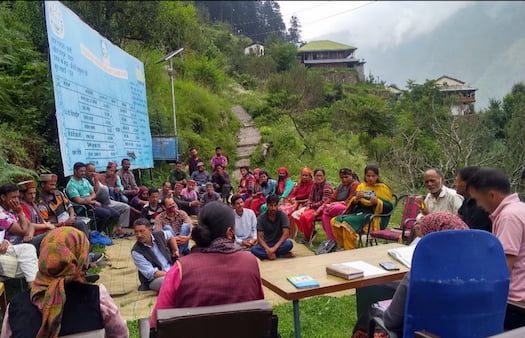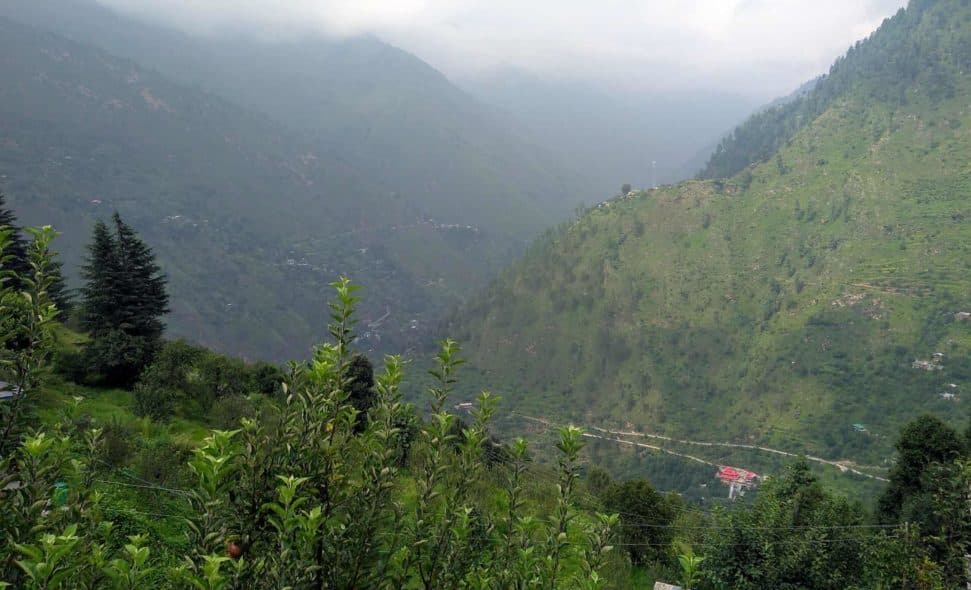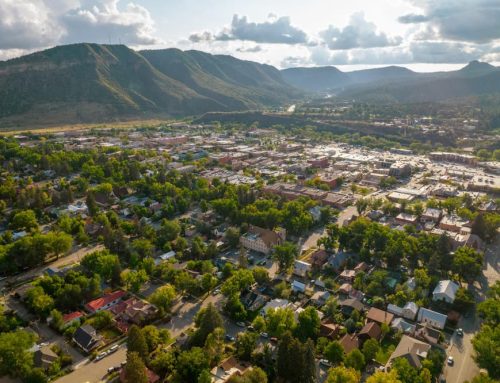Destination Stewardship Report – Autumn 2021 (Volume 2, Issue 2)
This post is from the Destination Stewardship Report (Autumn 2021, Volume 2, Issue 2), an e-quarterly publication that provides practical information and insights useful to anyone whose work or interests involve improving destination stewardship in a post-pandemic world.
A Himalayan Village Takes Charge of Its Future
After witnessing unprecedented environmental damage, and despite pressure from tourism investors, the Indian village of Sharchi put regulations in place to limit unbridled growth in its attractive Himalayan valley. Aditi Chanchani and Sandeeep Minhas detail how the valley’s village councils are coming together to protect the region’s nature, culture, and its very future.

Stakeholders gather in the Sharchi Village for a discussion on tourism at the Gram Sabha Meeting. [Photo courtesy of Aditi Chanchani]
Strengthening Tourism Governance: First Step to Sustainability
The Tirthan and Sainj Valleys of the Himalayas are in the northern Indian state of Himachal Pradesh in the Kullu District and adjoin the Great Himalayan National Park (GHNP). While this area has long been popular within the trekking community, it gained prominence on the tourist map about a decade ago and got further impetus when GHNP gained inscription as a UNESCO World Heritage Site in 2014. Markers of unplanned and unsustainable tourism development are on the rise in the Tirthan Valley, with the growth of hotels, resorts, campsites, hostels, and homestays on the periphery of the park’s boundaries.

What tourists come for: The view into the Great Himalayan National Park. [Photo courtesy of Aditi Chanchani]
Disasters in the Indian Himalayan region have increased in intensity and pace, with landslides blocking roads and rivers, leading to the loss of lives, livelihoods, and property. So far in 2021, Himachal Pradesh witnessed 35 major landslides (as compared to 16 in 2020), cloudburst occurrences have increased by 121% (around 30 this year), and there have been 17 incidents of flash floods (9 in 2020). Climate change and anthropogenic activities, with tourism being a contributor, are mainly responsible for the massive destruction that we are currently witnessing. Ironically, even during the peak of the COVID-19 pandemic when travel came to a standstill, the four-laning of highways and construction of tunnels, ropeways, hotels, and homestays continued unabated, especially in the remote regions of the state.
Tourism in the mountain regions is dependent on forests, grasslands, and natural ecosystems as well as human societies and cultures. The impact of excessive, unregulated tourism has resulted in unplanned urbanization, loss of traditional livelihoods, severe and lop-sided demands on scarce and fragile natural resources (forests, water, and land), deforestation, pollution, traffic jams, and spiralling prices. The safety of women and children and the loss of cultural traditions remains a constant fear.
Enabling Governance Makes a Difference
In India, there is no specific legislation for tourism that is all-encompassing (and maybe rightly so, given the multi-faceted nature of this sector, and the needs of different geographies and cultures). There are however two legislations that provide a framework for the planning and regulation of tourism at the local level.
- First, the Panchayati Raj Act (1994), which allows for the organization of village councils (called Panchayats) and endows them with the authority to function as units of self-government.
- Second, the Scheduled Tribes and Other Traditional Forest Dwellers Act (2006), which empowers holders of forest rights to protect, preserve, regulate, and put a halt to or refuse to allow any activity that has a detrimental impact on the wildlife, forest, biodiversity of the area and which negatively affects their natural heritage and culture.

Construction is underway to build in lanes for the Kullu Highway. [Photo courtesy of Aditi Chanchani]
With 66% of the geographical area of Himachal Pradesh covered with forests and with ample examples of negative impacts of tourism, the village councils (called the Gram Panchayats), the village assembly (called the Gram Sabha)[1] and the Conservation and Management Committees[2] have become key institutions for the planning and governance of tourism in and around forest areas.
Sharchi Village Decides to Regulate Tourism
On the boundary of the GHNP in Himachal Pradesh, Sharchi village, with a population of only 2,413, has taken a stand to prevent the exploitation of the environment and to protect the aesthetic value of the village.
In the past year, residents have seen a drastic increase in the sale of land with scenic views of the GHNP, mainly by people outside the state who wish to start tourism businesses.[3] This has propelled the Sharchi Panchayat (village council) to plan and regulate tourism and curtail commercialization while preserving the natural landscape and cultural traditions of the area.
Other Villages Join In
In July 2021, seven Panchayats of the Tirthan Valley passed a resolution that to open a tourism business requires a No Objection Certificate, or a written permission, from the local Panchayat. They also decided that the construction of hospitality units will be limited to a maximum of 10 rooms. This decision created a stir among tourism developers who had already invested in land or planned to invest in the area, and who now feared restrictions. The district’s Deputy Commissioner[4] was roped in to intervene.
Recognising that tourism impacts go far beyond that of just hotel construction, SAHARA [5] (Society for Scientific Advancement of Hill and Rural Areas) and Himalaya Niti Abhiyan, two civil society organisations, are working with the region’s communities to further their understanding of tourism and its impacts. The hope is to work towards a long-term, sustainable, and mature tourism plan able to withstand the ever-increasing impacts of tourism on the environmental, economic, and socio-cultural resources of the region.
Both organizations worked together with the Sharchi Village to prepare a memorandum to the Deputy Commissioner. A public notice was also posted inviting comments and suggestions.
Key points in the memorandum included:
- Tourism is developed and promoted so as to respect the land, its people, and natural and cultural heritage.
- Tourism development is undertaken with people’s consent, keeping to their views for how tourism should develop.
- Planning and implementation processes are transparent, participatory, and inclusive, and local tourism policy respects people’s vision and aspirations.
- Tourism is regulated, and decisions and norms developed by local communities and local governance bodies are upheld.
- People’s rights over common and community property resources and natural resources are ensured.
- Tourism is developed based on the carrying capacity of the region.
- Local ownership is strong, small and medium enterprises are vibrant, local employment and local economies are stimulated by tourism development.
- Tourism is culturally sensitive, striving to balance the need for commercial viability with the supporting and reviving of cultural traditions, arts, and crafts.
- The sacred spaces of the local deities (Nagaddi) are protected.
- Tourism industry does not expropriate communities’ land, water, or natural resources, nor alienate or displace people from traditional livelihoods.
- Tourism practices ensure responsible use of resources, low energy use, effective waste management, and minimum negative impact on the environment.
On August 30th, a meeting was held with the District Commissioner, who was positive about the steps that the community has taken. However, implementation depends on approvals from the Gram Sabha, District Administration, and State Government. As of publication, these meetings are pending.

Villagers practice the ceremony of welcoming the Devtas (Gods) during a festival in Jamad Village. [Photo courtesy of Aditi Chanchani]
The Way Forward
The next few years are crucial, as it will define the tourism trajectory of these remote regions of Himachal Pradesh. The people of Sharchi are not against tourism or businesses that would like to operate in the area, but they see this as a matter of their rights and the survival of their culture. SAHARA, Himalaya Niti Abhiyan, and the Panchayats are working on a sustainable tourism policy and action plan for the Valleys that involves all, both rightsholders and stakeholders (as the impact will be felt cumulatively). Additionally, they see the need to put in place institutional mechanisms that consider, and in fact accord primacy, to constitutionally guaranteed governance structures.
The people of Sharchi have taken a step in the right direction to embark on the long road towards achieving sustainable tourism. We will face many trials and tribulations, but we hope that we are able to stay on the path we have chosen.
[1] Gram Sabha or a village assembly which shall consist of all adult members of a village.
[2] Committees from amongst its members work to protect wildlife, forest, biodiversity, catchments areas, water sources and other ecologically sensitive areas; to shield the habitat of forest-dwelling communities from any form of destructive practices affecting their cultural and natural heritage; and to ensure that the decisions taken in the Gram Sabha to regulate access to community forest resources and stop any activity which adversely affects the wild animals, forest and the biodiversity are complied with.
[3] To protect the rights of the people of Himachal Pradesh, non-locals are not allowed to purchase land unless approval is given by the State and therefore through other means, circumvent this process.
[4] Deputy Commissioner is representative of the government at district level and is responsible for the implementation of programmes and policies of Centre Government and State Government as well as to coordinate the working of all Government offices within the district. The Commissioner looks after the law and order situation and is the primary relief agency in cases of natural calamities (https://himachalservices.nic.in/rti/rtihp/RTIDesc/117-2.pdf accessed as on 14 October 2021).
[5] SAHARA is a registered society that came into being with a mandate of empowerment of women in the interior areas of Kullu district. They work towards addressing the economic and social needs of the communities living adjacent to the Great Himalayan National Park.
About Aditi Chanchani and Sandeeep Minhas
Aditi Chanchani and Sandeeep Minhas are associated with Himalaya Niti Abhiyan, a collective of grassroot people’s resistance defending local livelihoods, environment, and social equity with the idea of a sustainable mountain-specific development model. A key area of their work has been to advocate and fight for the implementation of the Forest Rights Act. Sandeep Minhas is Secretary of organisation, while Aditi Chanchani coordinates Mountains, Communities and Tourism programme. Aditi is a member of the GSTC India Working Group and of the GSTC Destination Stewardship Working Group.




